

Art in Alternative Spaces
Featured Artist
...All From Just Toothpicks
Toothpick Models of Early 20th Century Ocean Liners
by Chicago Outsider Artist
Wayne Kusy
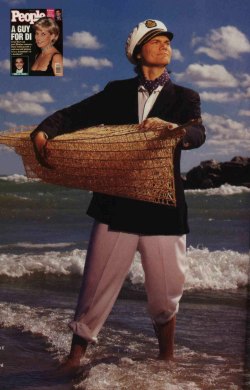
WAYNE KUSY (Pictured above in People Magazine Aug. 25, 1997) builds models of early 20th century ocean liners out of toothpicks. Not just small mantle size replicas, but structures measuring up to 25 feet in length and hundreds of thousands of toothpicks. Here is the fleet which has been featured in People Magazine, The Smithsonian, NBC Dateline, CNN Headline and hundreds of other media worldwide.
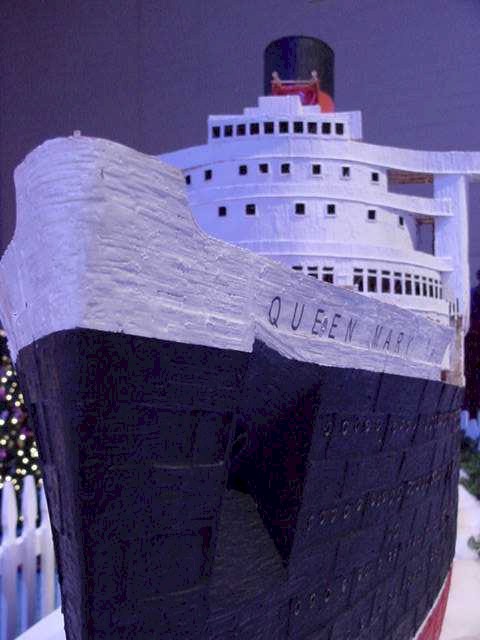
QUEEN MARY (Work In Progress)
25 feet long and already 370,000 toothpicks.
Estimated tally of toothpicks when completed:
1,000,000 toothpicks and 30 gallons of glue
In 2001, Wayne Kusy's toothpick replica of the Queen Mary was exhibited at WINTER WONDERFEST at Chicago's Navy Pier. A 2 year work- in-progress, the ship is 25 feet long and made of 540,000 toothpicks and 11 gallons of wood glue -- so far. It is built in 6 sections and weighs approximately 200 pounds. With every show, something new is added. In approximately a year, Wayne estimates it will be complete.
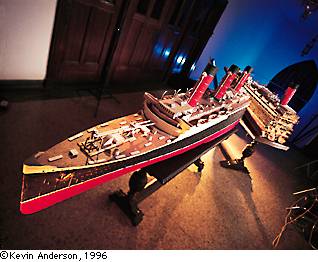
LUSITANIA
16 feet long at 194,000 toothpicks and five gallons of glue.
Tool approximately two and a half years to construct
on an average of 2-3 hours a night.
Because of the astounding success of the movie, many mistaken Wayne Kusy's model of the Lusitania for the Titanic. Both ships had four funnels (smokestacks) and they had the typical dreadnaught shape with flat prow common in early 20th century steamships. Though the real Lusitania did not break in half as did the Titanic, Wayne's model is built to separate to get in and out of his apartment. Lusitania was the ship sunk by a German torpedo at the onset of World War I in 1915. Three years after the sinking of the Titanic.
The Lusitania was completed in 1994 after two and a half years of tedious work. Wayne's technique of bending and breaking and cutting toothpicks into the form of a ship had reached another plateau. Not only did the Lusitania have portholes and stairs, it had copper porthole covers and stairwells. Not only did it have well decks and lifeboats, it also had open weather decks and lifeboat oars and seating. The skeleton frame infrastructure, which supports the integrity of the ship was reinforced with over 5 gallons of wood glue.
The Lusitania is built in two sections. Both pieces can store easily by standing on end straight up toward the ceiling. Joining these two sections is a toothpick interlocking deadbolt system. This is a system of two sets of toothpicks shafts. Each shaft is connected to each section of the ship. When the sections are closed to make the ship whole, the adjoining shafts meet at a common endpoint. A household curtain rod acts as the deadbolt to fasten the pieces and tighten them in place. So tight is it, that one has a hard time seeing the seam.
Lusitania is the ship that brought Wayne Kusy world attemtion for his amazing craft/artwork. Covered by CNN and the Chicago Tribune, he had made his beginnings as an outsider artist. Lusitania has been pictures in over 100 publications around the world. If you would like to see the ship, it's docked at Baltimore's AMERICAN VISIONARY ART MUSEUM.
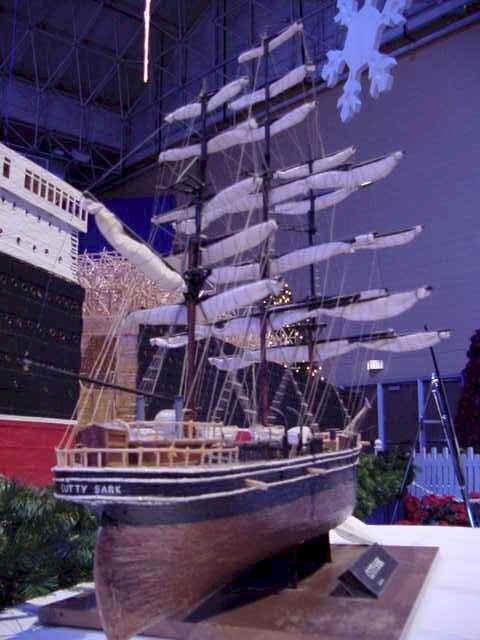
CUTTY SARK
8 feet long at 16,000 toothpicks.
Left as a skeletal structure for exhibition purposes.
The Cutty Sark was built in 1998 from
12,000 toothpicks and 130 ounces of glue.
It only took 3 months to construct. The sails are made of Bounty paper towels. The decals are hand drawn. Finished with rigging and furled sails.
CUTTY SARK (mini not pictured)
The mini Cutty is 4 feet long at 12,000 toothpicks. It is completed, painted and fully rigged with furled sails. The mini Cutty is primarily a demonstration model.
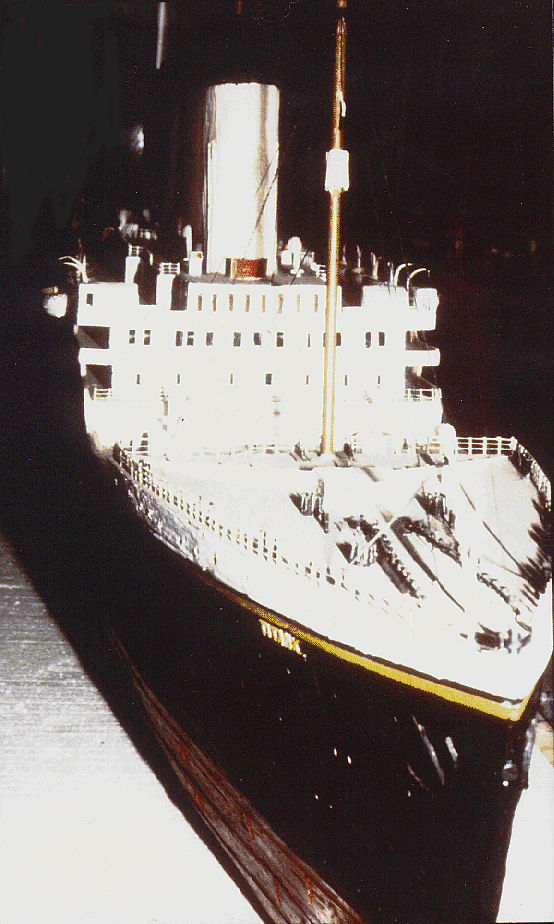
TITANIC
10 feet long at 75,000 toothpicks and 1 Gallon of glue.
Took approximately a year and a half to construct
on an average of 2-3 hours a night.
The Titanic was Wayne Kusy's first replica of an actual vessel. Up until this point, all of his previous works were products of his imagination inspired by vessels of sail of the 18th and 19th century. The Titanic would be the first ship that would re-invent Wayne's miniature engineering skills. It would be three times longer and over twenty times larger in cubic size than anything else he built before. Not only did he have to build a hull, but a fortress like superstructure. Not to mention hundreds of details from the smokestacks to the portholes. This project would take him over a year and a half to build.
Inspired by a 1982 attempt to locate the wreck of the Titanic, Wayne sought information from the local library to make his model as accurate as possible. This involved pouring through deck plans, copies of known blueprints, photos and a plastic model to make sure the job was done right. In order to shape the complex hull, Wayne first had to build an infrastructure or a skeleton, then clad it with toothpicks like bricks. The skeletal frame is built just like a real ship. He started out formulating a set of 20 vertical frames which would be spaced and connected into the form of a hull. The skeleton had to be strong enough to withstand over one hundred times it's own weight, if his ship were to last the test of time.
As like the real ship, Wayne's Titanic was built in two phases. The hull was constructed first, then, the superstructure. The superstructure is the part of the ship above the hull which contains the captain's bridge, smokestacks, etc. In a real ship yard, the hull is launched first. It is then towed to a place called the fitting yard, or the place where they build the superstructure and fit it with all the furnishings you would see in a ship. Large ships are launched hull only. The reason is that they tend to be top heavy and much safer to drive out a dry dock and into the water. The Titanic is now resting at the Carol & Barry Kaye Museum of Miniatures in West Los Angeles at 5900 W. Wilshire Blvd.
For more information, please contact:
Anatomically Correct
email: anatomicallycorrect2022@gmail.com